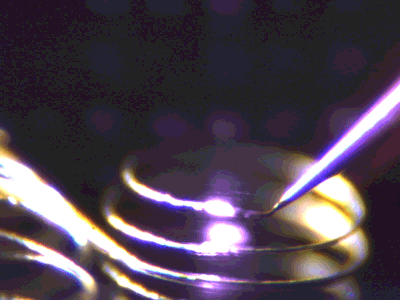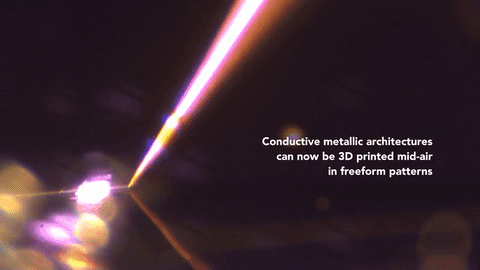Check Out this Amazing 3D Printer That Prints Complex Structures in Midair Using Lasers and Metal Nanoparticles
 A team of researchers at Harvard’s Wyss Institute for Biologically Inspired Engineering and John A. Paulson School of Engineering and Applied Sciences (SEAS) has developed an eye-popping new method of 3D printing complex metallic structures in midair. The incredible 3D printing process uses a high-powered laser to anneal nanoscopic particles of conductive metallic inks with no need for any sort of support structures. The technology is capable of annealing flexible and complex metal electrodes and structures that can be used in the manufacturing of wearable electronics, sensors and antennas for use in small, customized electronic and biomedical devices.
A team of researchers at Harvard’s Wyss Institute for Biologically Inspired Engineering and John A. Paulson School of Engineering and Applied Sciences (SEAS) has developed an eye-popping new method of 3D printing complex metallic structures in midair. The incredible 3D printing process uses a high-powered laser to anneal nanoscopic particles of conductive metallic inks with no need for any sort of support structures. The technology is capable of annealing flexible and complex metal electrodes and structures that can be used in the manufacturing of wearable electronics, sensors and antennas for use in small, customized electronic and biomedical devices.
This laser-assisted direct ink writing method is capable of printing free-standing, microscopic metallic 3D structures in a single step without requiring the use of any support materials. The process that Wyss Core Faculty member and team leader Jennifer Lewis Sc.D. helped develop uses conductive inks composed of silver nanoparticles that are sprayed through a very fine printing nozzle. A specially programmed laser is used to apply a specific and precise amount of energy to trigger the ink’s solidification. Developing the process required the team to create a formula that would optimize the nozzle-to-laser separation distance.
“If the laser gets too close to the nozzle during printing, heat is conducted upstream which clogs the nozzle with solidified ink. To address this, we devised a heat transfer model to account for temperature distribution along a given silver wire pattern, allowing us to modulate the printing speed and distance between the nozzle and laser to elegantly control the laser annealing process ‘on-the-fly’,” explained the study’s first author, Wyss Institute Postdoctoral Fellow Mark Skylar-Scott, Ph.D.
Not only does the flow of nanoparticles in the nozzle need to be precisely controlled so the metal thread’s width will remain uniform, but the laser also needs to be accurately adjusted so no particles are left un-annealed. The high tech 3D printing nozzle is capable of moving along the X, Y and Z axes, and also includes a rotary print stage that enables the printing of freeform curves. The process is so precise that it can print tiny hemispherical shapes and spiral motifs suspended in free space within seconds. It was even used to print a butterfly made of silver wires that are thinner than the width of a strand of human hair.
The 3D printed wires offer excellent electrical conductivity properties that near the quality of bulk silver. The laser-assisted direct ink writing process is vastly superior to more conventional 3D printing technologies commonly used to print conductive metallic structures. The computer-controlled printing nozzle can be used to make sweeping curves and spirals as well as sharp angles and complex directional changes. Not only is it able to produce smaller and more accurate curves in a single step but it can also be used to print electrically conductive silver wires directly on a wide variety of low-cost plastic substrates.
“This sophisticated use of laser technology to enhance 3D printing capabilities not only inspires new kinds of products, it moves the frontier of solid free-form fabrication into an exciting new realm, demonstrating once again that previously-accepted design limitations can be overcome by innovation,” said Wyss Institute Founding Director Donald Ingber, M.D., Ph.D.
The 3D printing process that the team developed is so new that it doesn’t even have a name yet, but that doesn’t mean that the early results aren’t incredible. The process could potentially open up virtually limitless new applications for the manufacturing of tiny, customized electronic and biomedical devices that would be impossible to fabricate using traditional methods. The Wyss Institute researchers published their findings online in the May 16th issue of scientific journal Proceedings of the National Academy of Sciences.
Check out this amazing video of the silver wires being 3D printed in mid-air. What do you think? Discuss in the Metal 3D Printed in Air forum over at 3DPB.com.
Subscribe to Our Email Newsletter
Stay up-to-date on all the latest news from the 3D printing industry and receive information and offers from third party vendors.
You May Also Like
3D Printing News Briefs, April 13, 2024: Robotics, Orthotics, & Hypersonics
In 3D Printing News Briefs today, we’re focusing first on robotics, as Carnegie Mellon University’s new Robotics Innovation Center will house several community outreach programs, and Ugogo3D is now working...
Rail Giant Alstom Saves $15M with 3D Printing Automation Software 3D Spark
3D Spark has entered into a three-year deal with the rail giant Alstom. Alstom, a transport behemoth with annual revenues of $16 billion, specializes in the manufacture of trains, trams,...
Meltio Expands Global Reach with New Partnerships in the Americas and Europe
Spanish 3D printing manufacturer Meltio has expanded its sales network across the globe. With the addition of three new partners in the United States, Brazil, Argentina, and Italy, Meltio aims...
3D Printing Webinar and Event Roundup: April 7, 2024
Webinars and events in the 3D printing industry are picking back up this week! Sea-Air-Space is coming to Maryland, and SAE International is sponsoring a 3D Systems webinar about 3D...

































